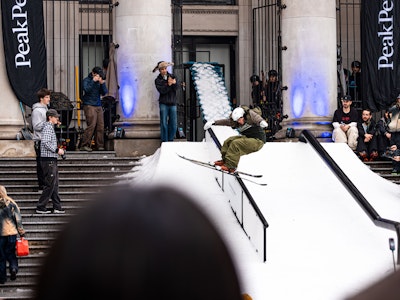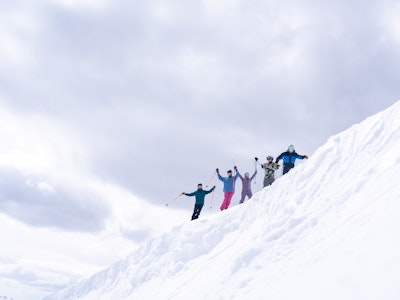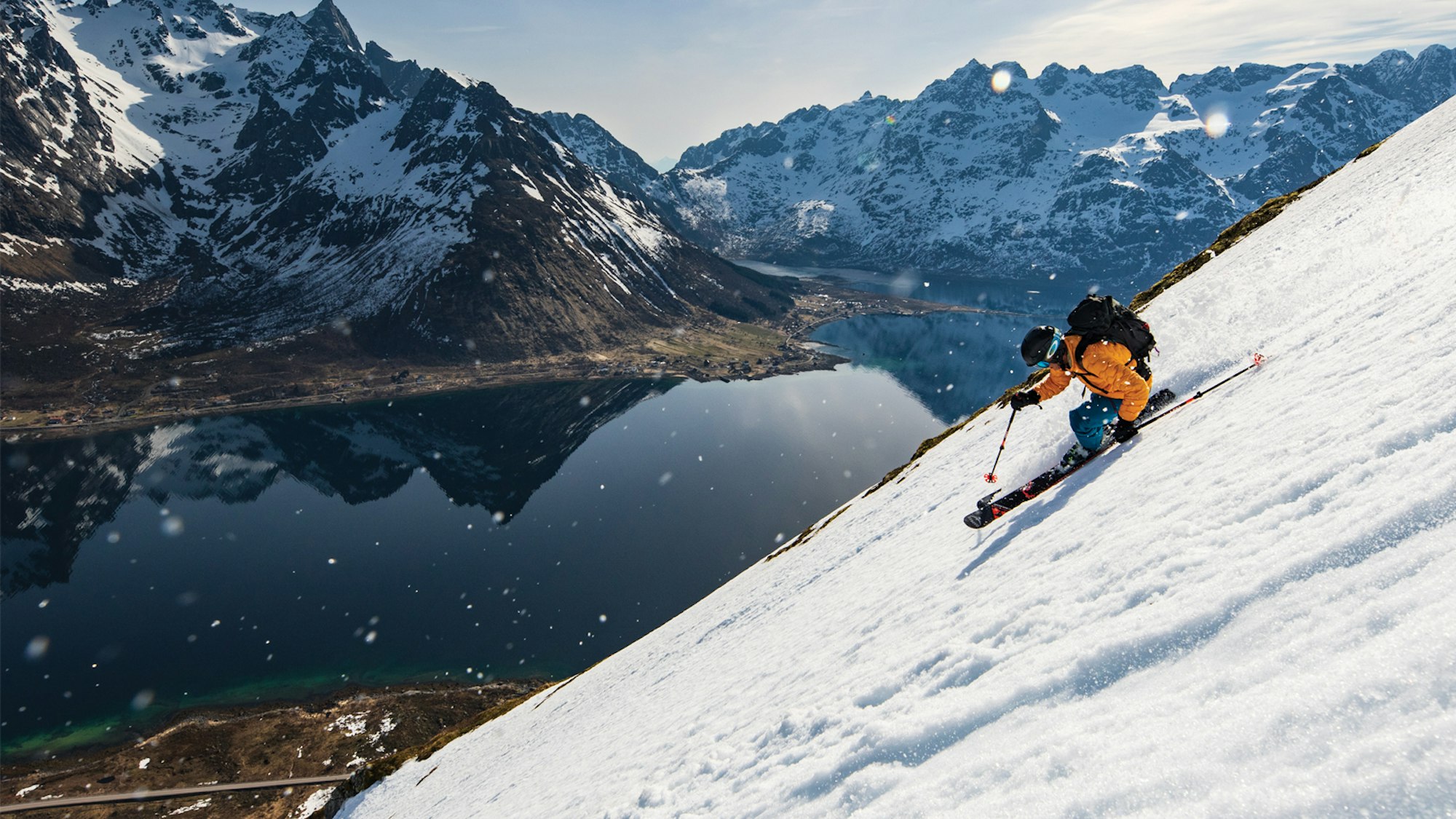The picturesque Norwegian archipelago is a haven for foot-powered adventure
WORDS • SVEN BRUNSO | PHOTOS • LIAM DORAN
After 25 years of traveling the globe in search of the Endless Winter, my skiing bucket list had dwindled to but one remaining destination: the Lofoten Islands of Norway. Over the years, I had projects scheduled for Lofoten, but my best-laid plans fell through for a variety of reasons. The goal of reaching the islands was starting to feel like I was chasing the elusive Holy Grail. Needing to add the final notch to my global ski belt, I decided I was going to make it to Lofoten this year no matter what. It didn’t take too much effort to convince photographer Liam Doran to join in on the springtime adventure as Lofoten is considered by many shutterbugs to be one of the most scenic locations on Earth.
The Lofoten Islands, located on the 68th parallel north and inside the Arctic Circle, can be accessed by flying from Oslo directly into Narvik and then driving west or by taking multiple flights on small planes into Svolvær. I had fond memories of the area around Narvik from previous ski trips, so we decided that was the perfect location to begin our journey. Liam was a first-timer to Norway, and watching his eyes light up as we descended into Narvik on our Norwegian Airlines flight was a treat. Deep blue waters lay glassy in the fjords beneath the wings as jagged snowy peaks jutted into the heavens above. As we taxied to Harstad-Narvik Airport’s sleek and modern terminal, our necks were stiff from craning to the right trying to soak in all the scenic treasures through the porthole-size windows.
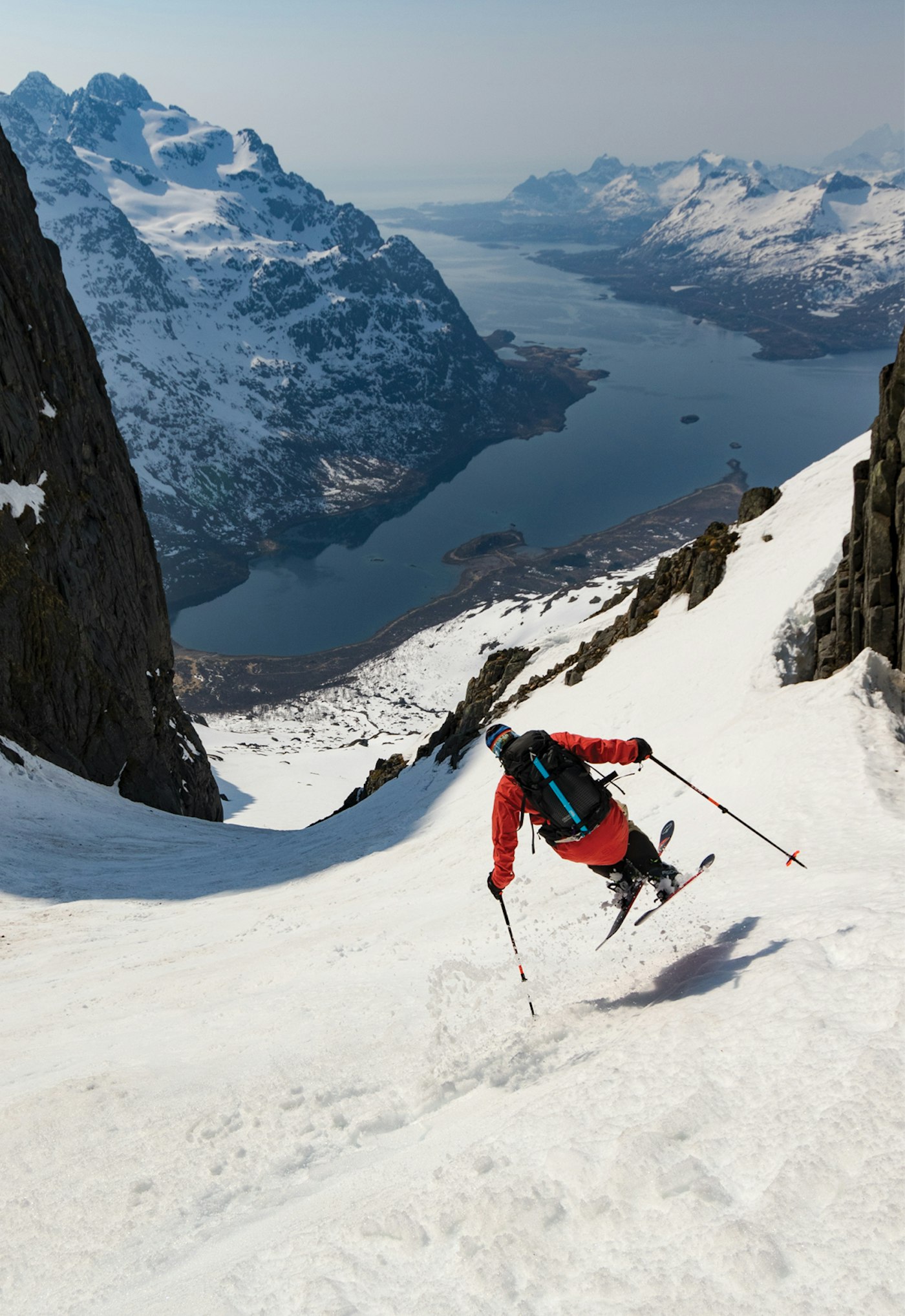
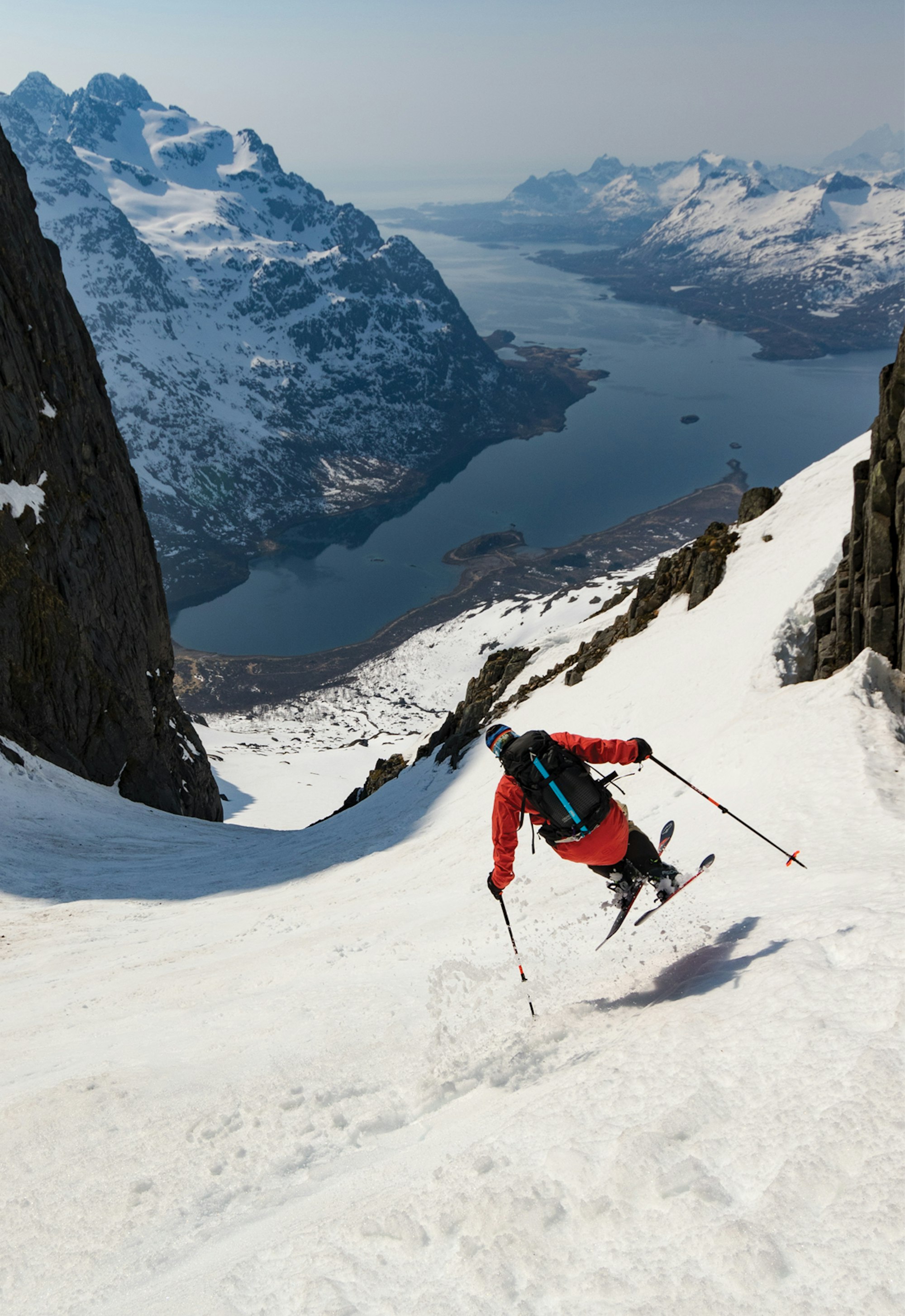
Author, Sven Brunso, skiing the South Couloir on the Geitgallien in the Lofoten Islands of Norway.
We spent a few days in Narvik using the lifts from the local ski area to provide easy access to a vast sidecountry zone called Mørkholla. On our last day in the area we skied the infamous Gangnesaksla Couloir, one of the biggest lines in Norway, providing an exposed descent from the summit to the Skjomen fjord 4,000 vertical feet below. With a few big ski days already under our belts, the adventure was off to a stellar start. As we headed west, the towering peaks surrounding Narvik faded in the rearview mirror, and we left mainland Norway behind and crossed the first of dozens of bridges onto the Lofoten Islands.
After three hours of driving, our capacity to process the mystical scenery was tapped as we passed through Svolvær and into the small village of Kabelvåg, a town with roots dating back to the Viking age. We turned off the E-10, the road connecting the entire island chain, descended to the ocean’s edge and were treated to our first glimpse of the Lofoten Ski Lodge. A weary but contented smile crossed my face as I realized this postcard-perfect setting was our home for the next week. The Lofoten Ski Lodge, painted in classic Norwegian red, was perched on pylons above the crystal-clear waters of a tranquil inlet tucked beneath rugged peaks of snow and granite.
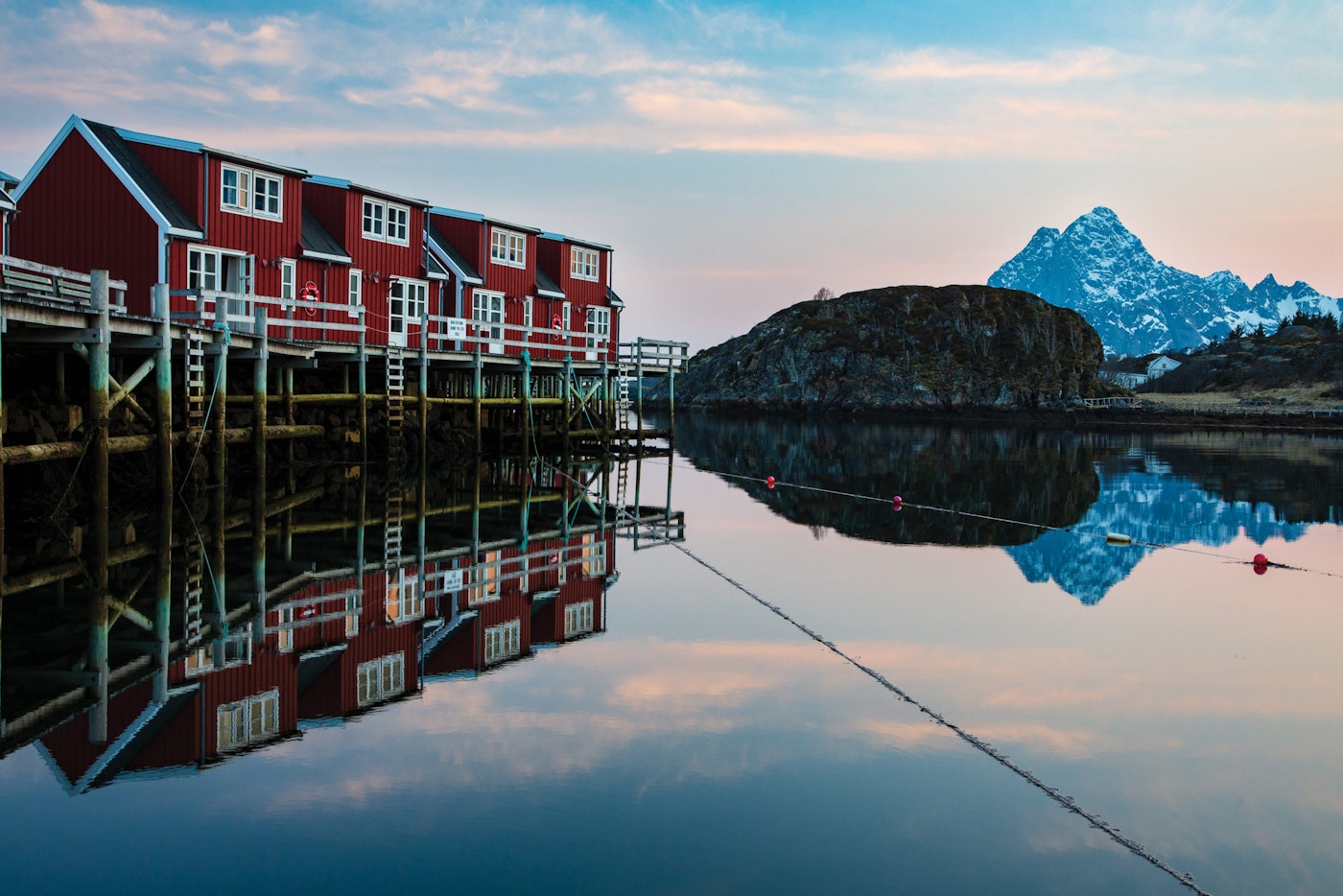
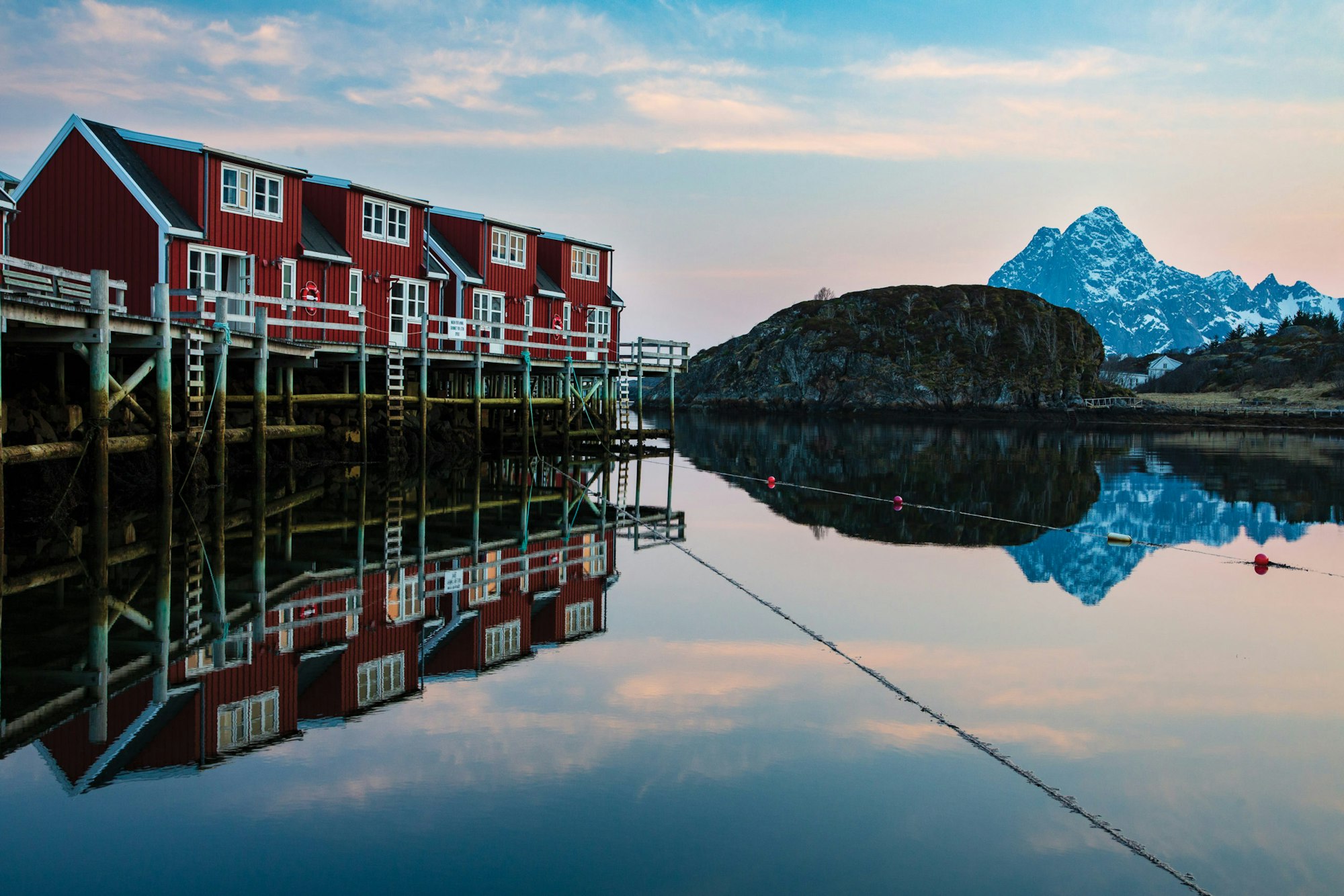
The Lofoten Ski Lodge is quintessential Norway.
We walked into the lodge and were quickly ensconced in the scent of waffles and coffee and we knew we had arrived in a backcountry skier’s Nirvana. We enjoyed a feast of waffles, a Lofoten Ski Lodge tradition, topped with Nutella and lingonberry jam. Afterwards, we met up with Mark Allen, one of the guides working for Northern Alpine Guides, which is owned by Seth Hobby, who also runs the lodge with his wife Maren. Without hesitation Mark took a Sharpie to our topo maps and went to work dialing us in with ample backcountry itineraries sure to keep us satiated for the coming week.
We easily settled into a comfortable daily routine of consuming massive amounts of calories and caffeine each morning before making a plan for the day. In Lofoten, all turns are earned, so no matter how big your eyes are, the amount of vertical you actually log is limited by your capacity to climb what you ski.
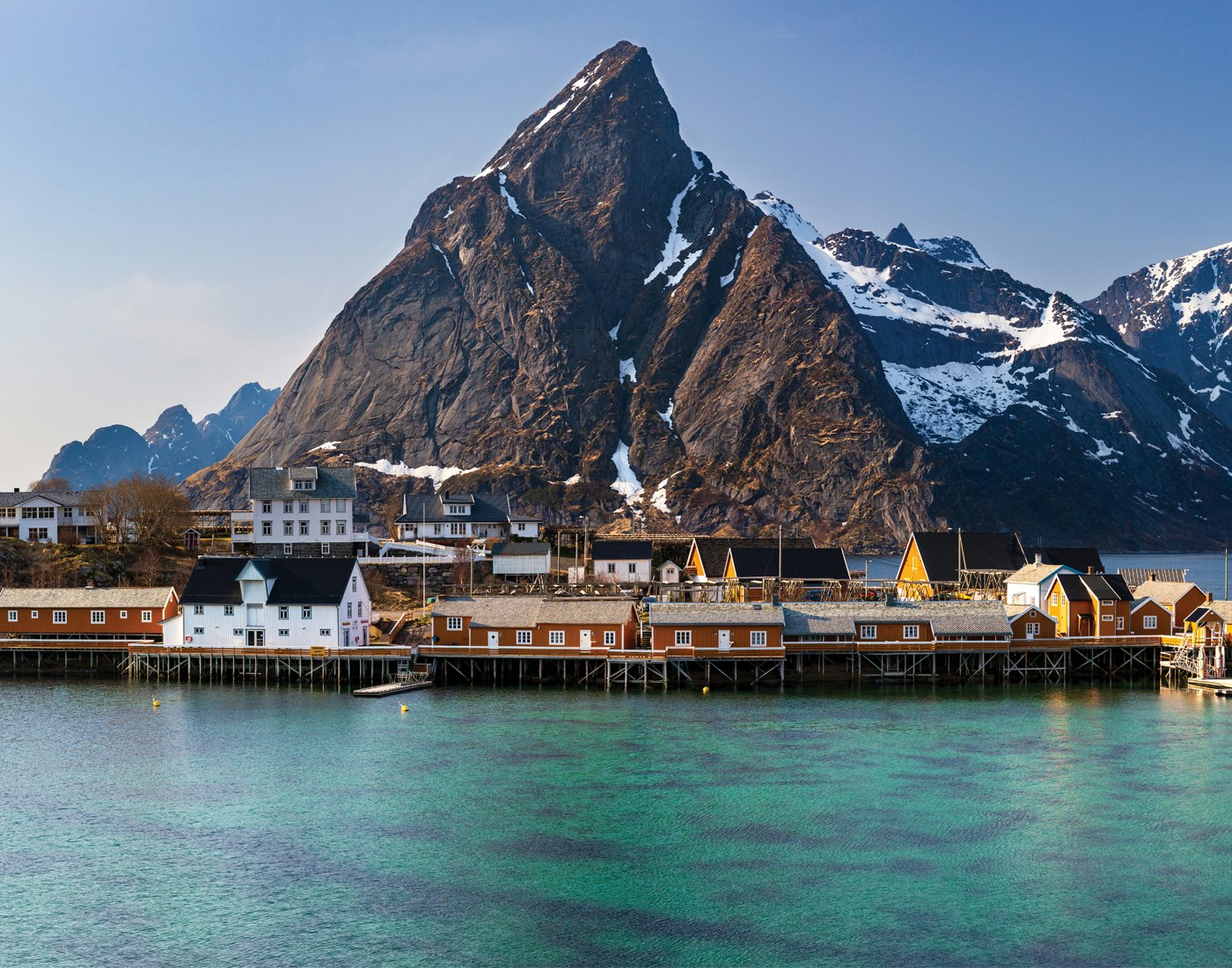
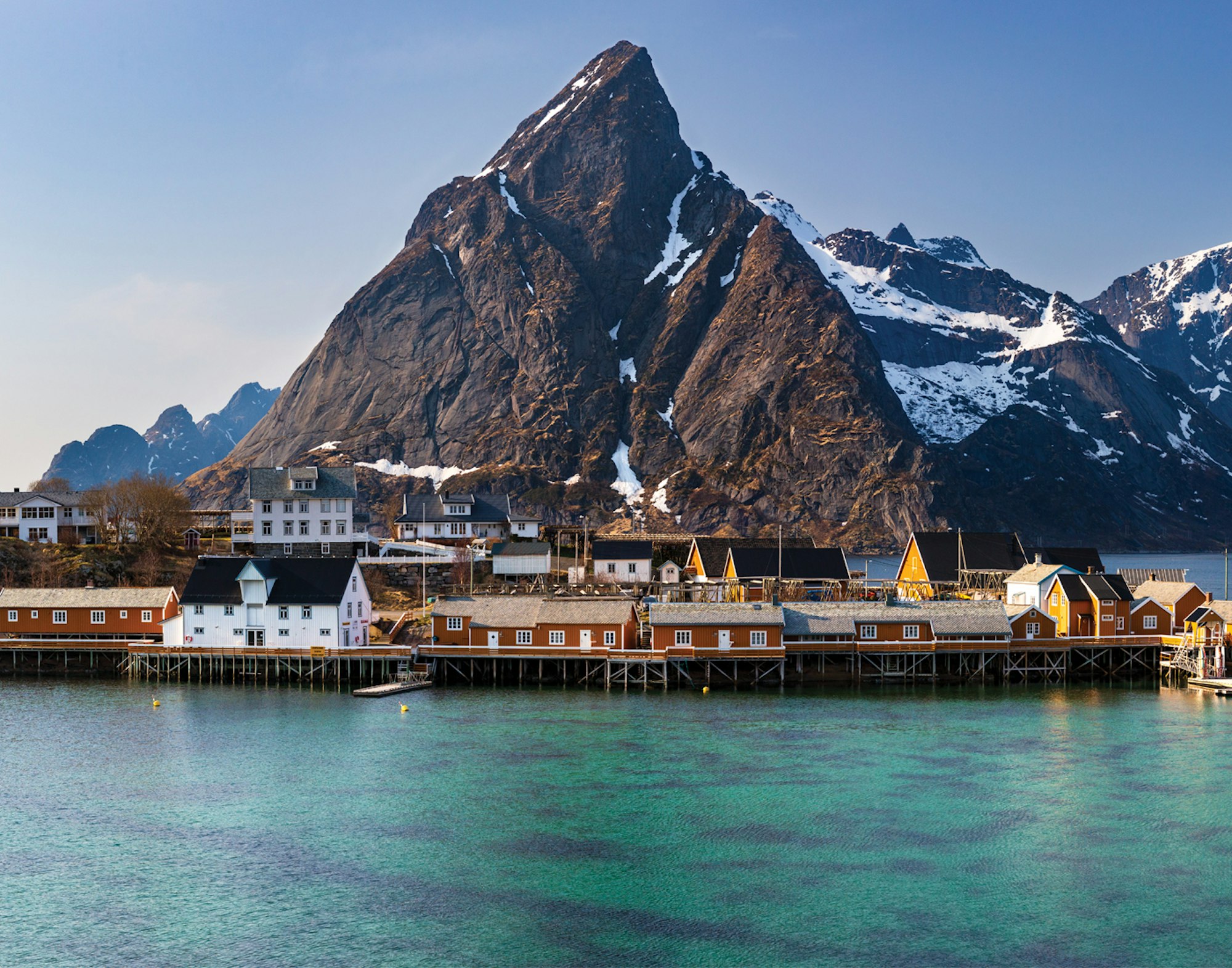
The ocean surrounding Reine may look tropical but the water temperatures are sure to cause shrinkage.
Coming from Colorado, Liam and I had been skiing and climbing at altitude all winter, so sea level starts made us feel like we’d been blood doping. There were some days we logged in excess of 5,000 vertical feet of climbing, but even those big days left us with 14-plus hours of daylight after our legs were cooked. Over my years of traveling, I have found that my favorite ski destinations are those where there is more than just great skiing. In that regard, Lofoten is without rival. We skied every day of the trip but also played tourists, driving between the islands, sightseeing, surfing and visiting some of the most awe-inspiring locales on the planet. Places like Henningsvær, Reine and Hamnøy were otherworldly. These tiny villages tucked beneath sheer mountain faces harbored colorful boats, vintage buildings and racks of drying cod that gave the air a unique aroma that I am hopeful will never be made into a candle scent.
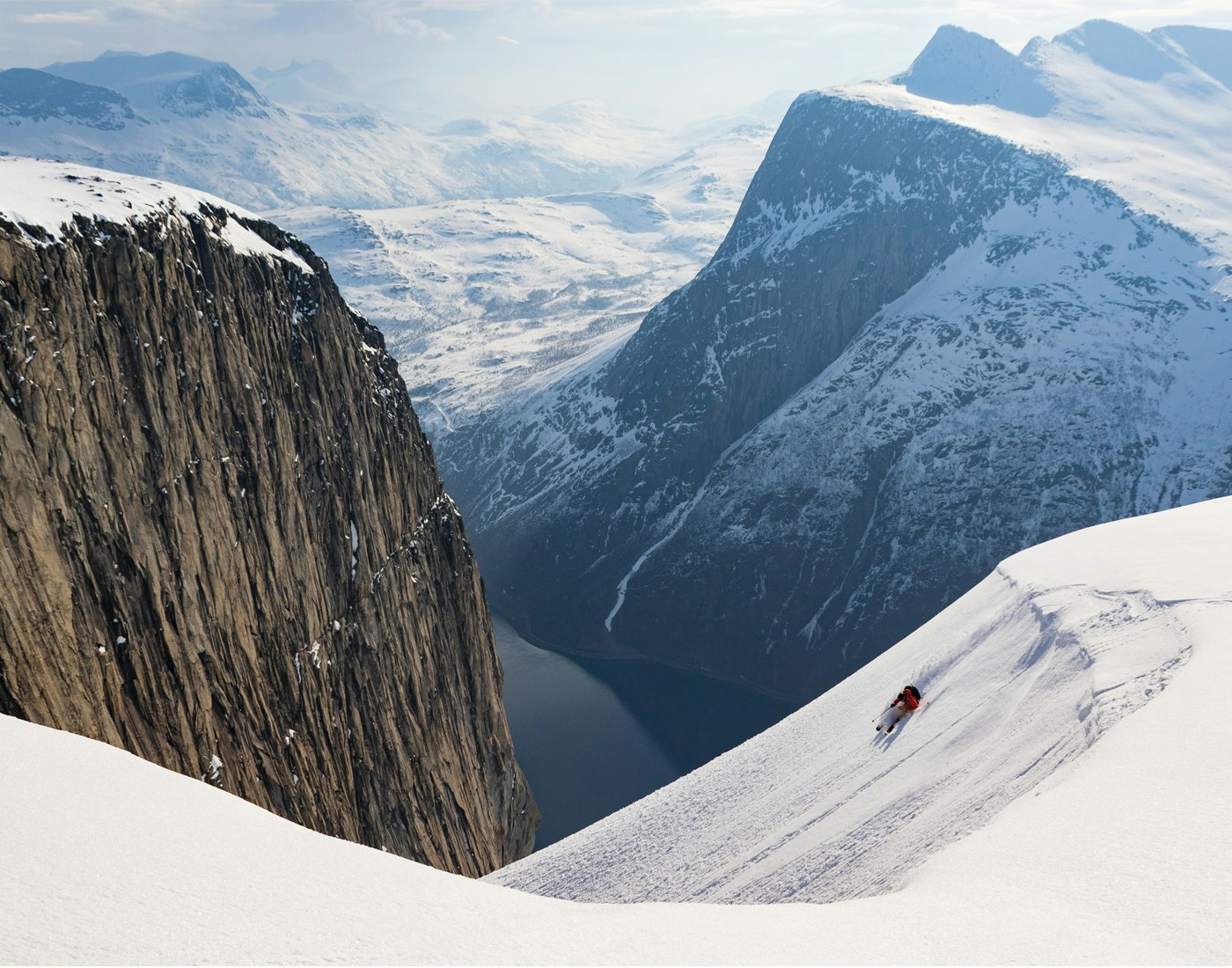
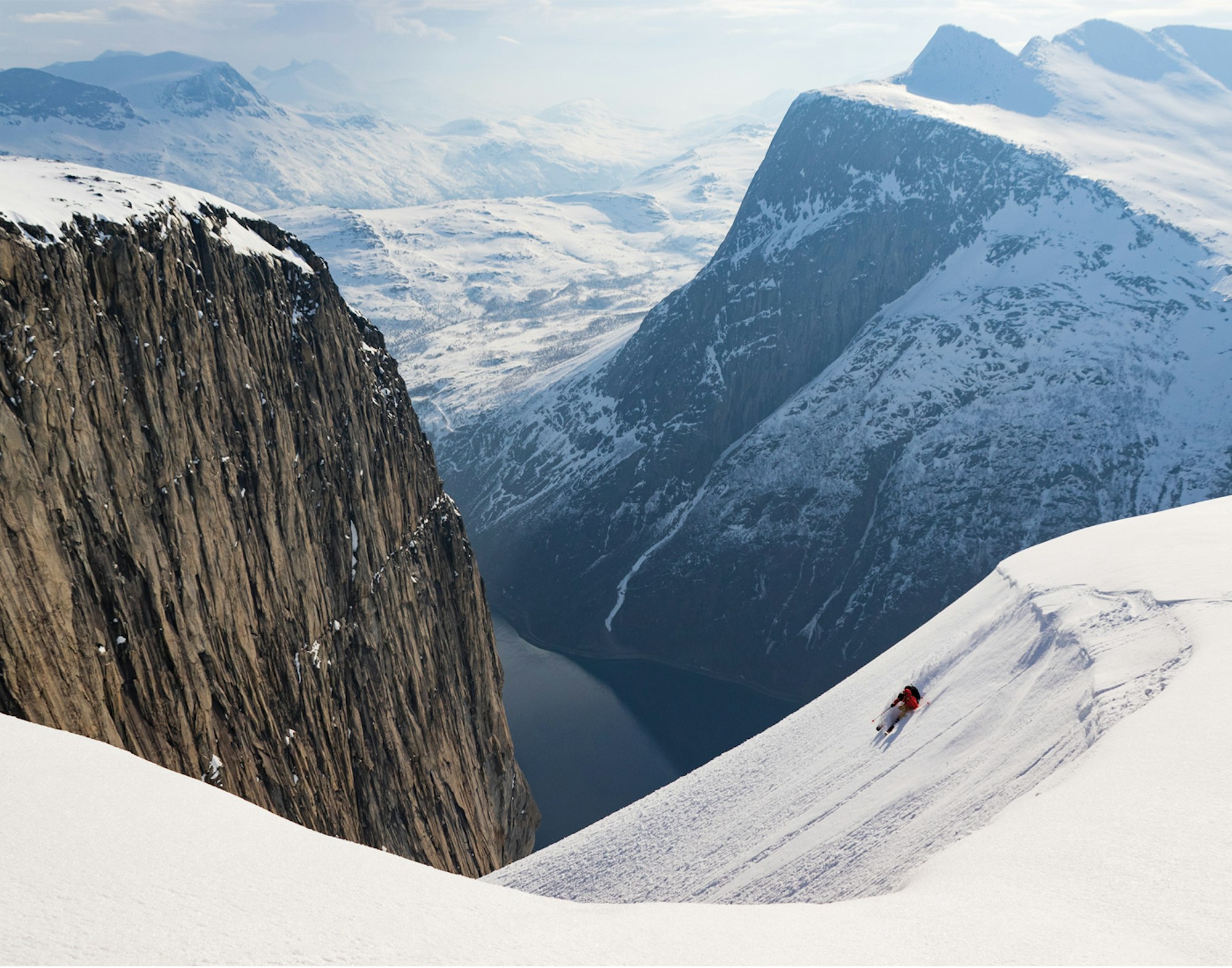
The author dropping into the Gangnesaksla Couloir, outside Narvick, Norway.
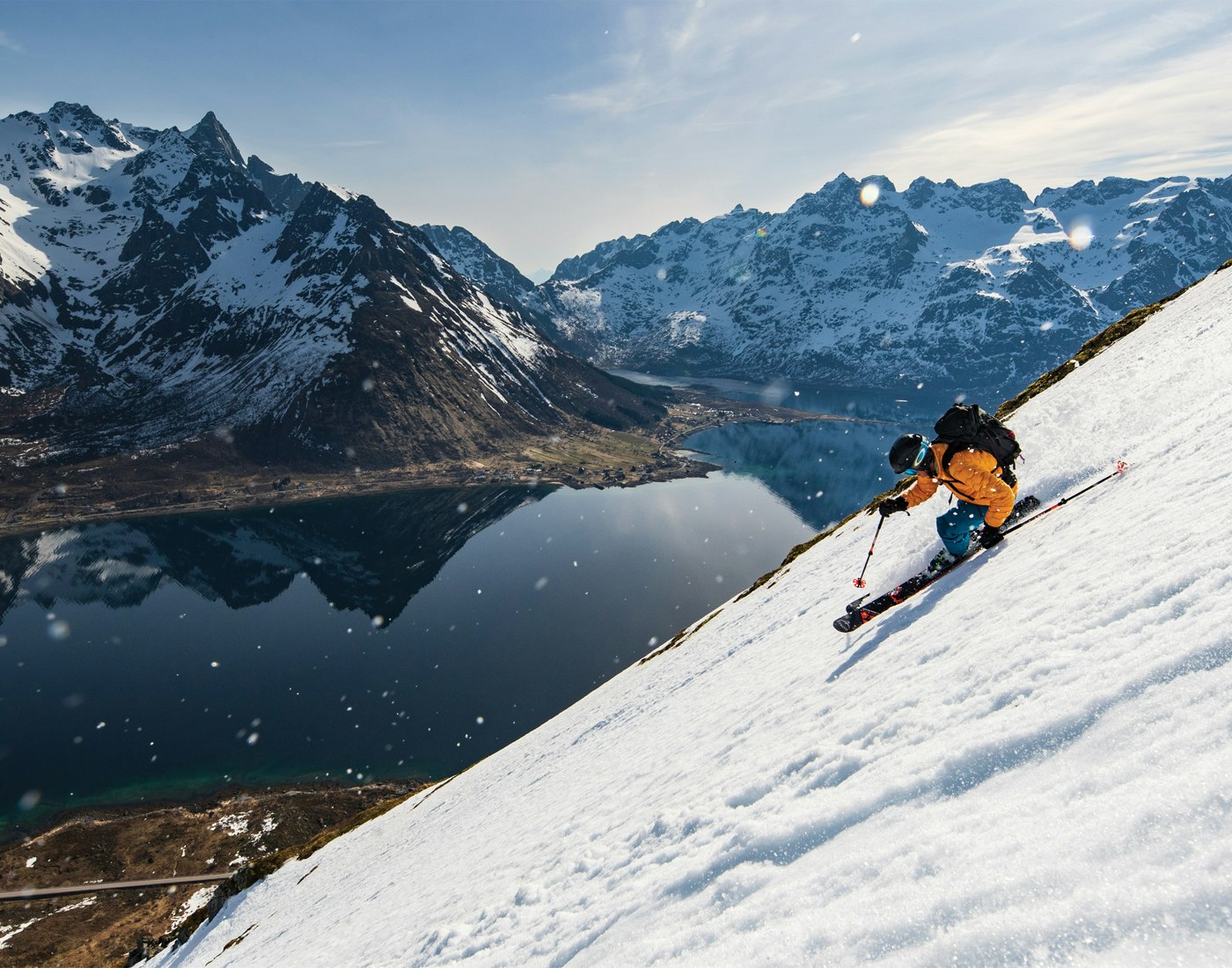
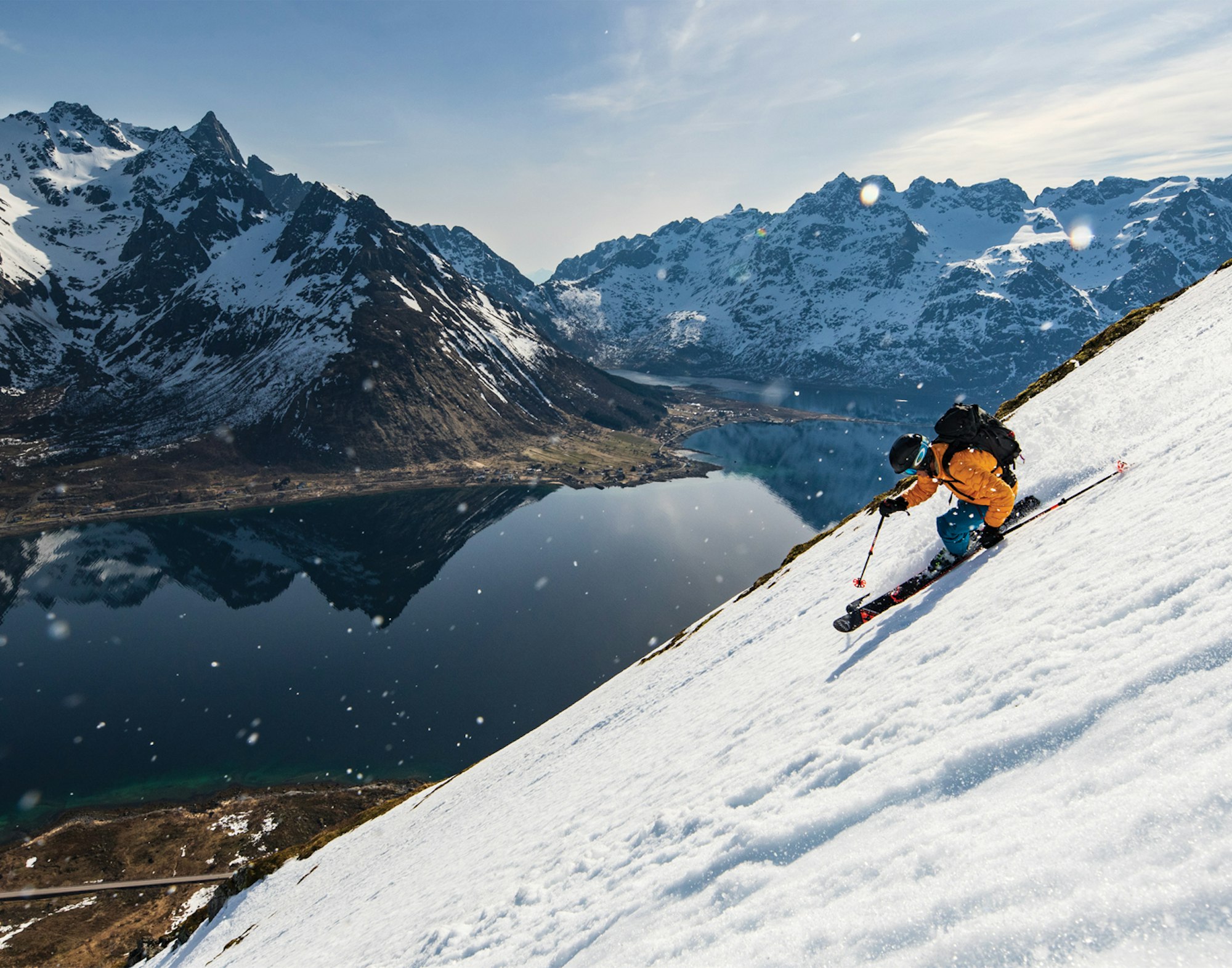
Sven Brunso harvesting corn on the island of Austvagoya, Lofoten.
During our week in Lofoten, we ticked off some classic lines on Rundfjellet and Blåtinden, both short drives from the Lofoten Ski Lodge. We had near-perfect spring skiing conditions morning, afternoon and late into the evening when it was possible to squeeze in a quick ski tour. Shredding after a dinner of oven-baked Norwegian cod with pesto and roasted fingerling potatoes is unbeatable. Being so far north, the sun is low on the horizon, keeping the snow in a perpetual state of perfect corn that we were all too happy to harvest. For two skiers from a land-locked state, the rare opportunity of being able to see the ocean from every summit was never squandered. There was something special about looking between our ski tips at the sea below and islands as far as the eye could see.
The highlight of the trip was climbing the peak of Geitgallien, one of the highest in Lofoten, and skiing the South Couloir, an area classic. For five days we spied on Geitgallien while skiing other objectives on the opposite side of the fjord, trying to figure out how to access the peak through what appeared to be a labyrinthine approach comprising bushwhacking, multiple stream crossings, exposed ridges and steep snowfields. As we would learn during our time in Lofoten, defining scale is nearly impossible. Over a few Aquavits, a high-octane Scandinavian spirit flavored with herbs, I showed the iPhone photos I had of the Geitgallien approach to Seth and he confirmed that while it appeared to be tricky, it would all come together once we were on the far side of the fjord and starting our ascent.
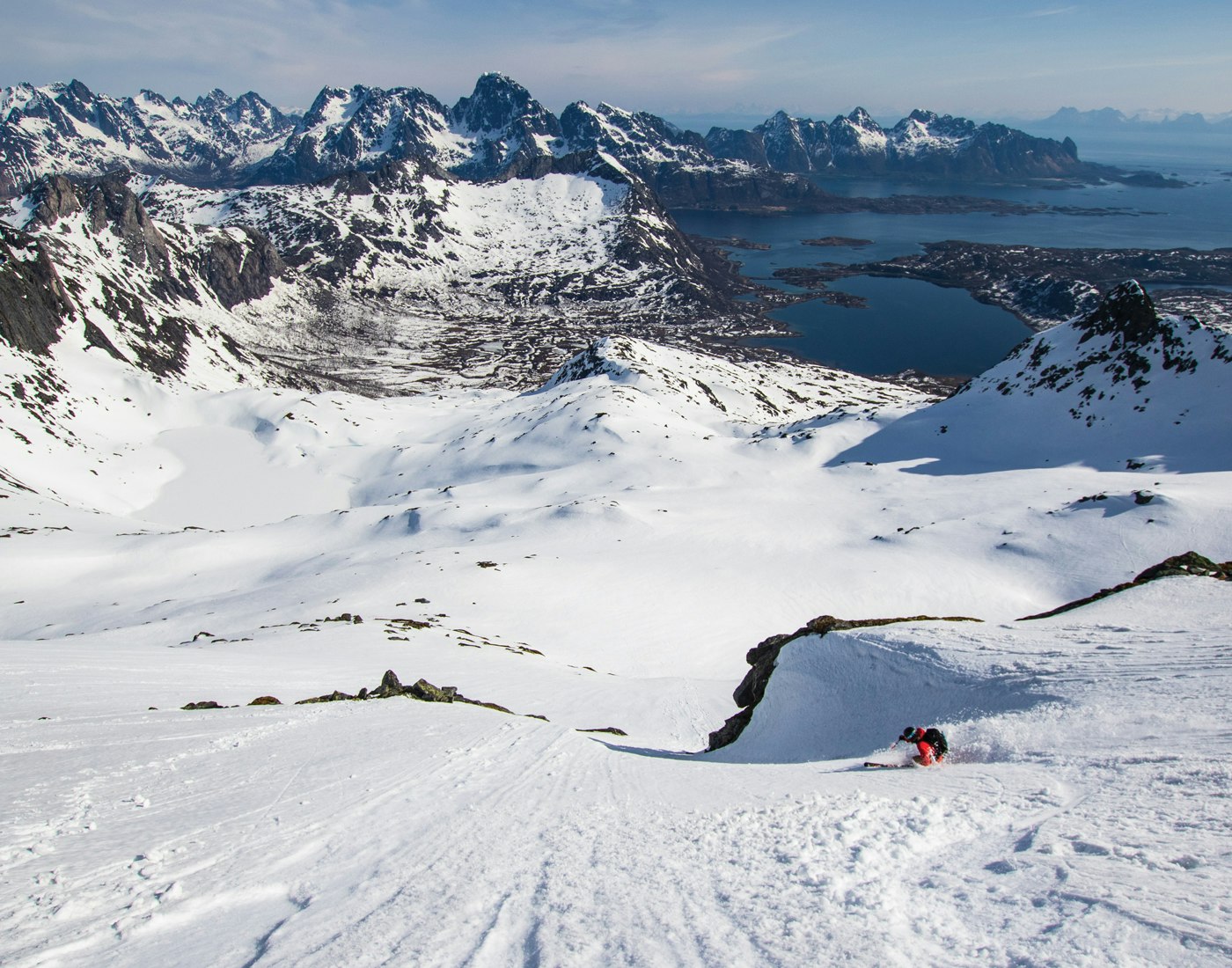
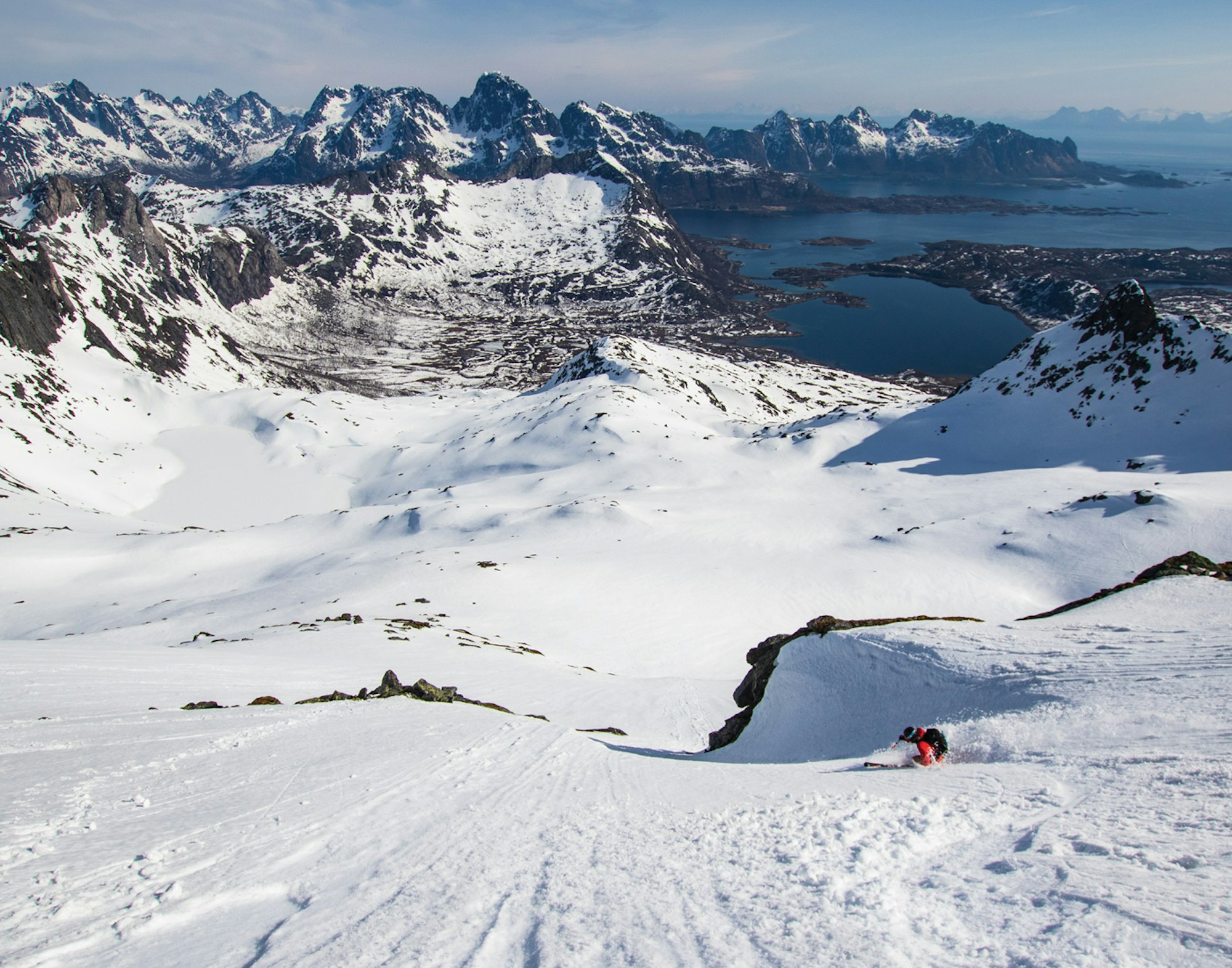
Savoring a summit-to-sea line off the top of Rundfjellet, Lofoten.
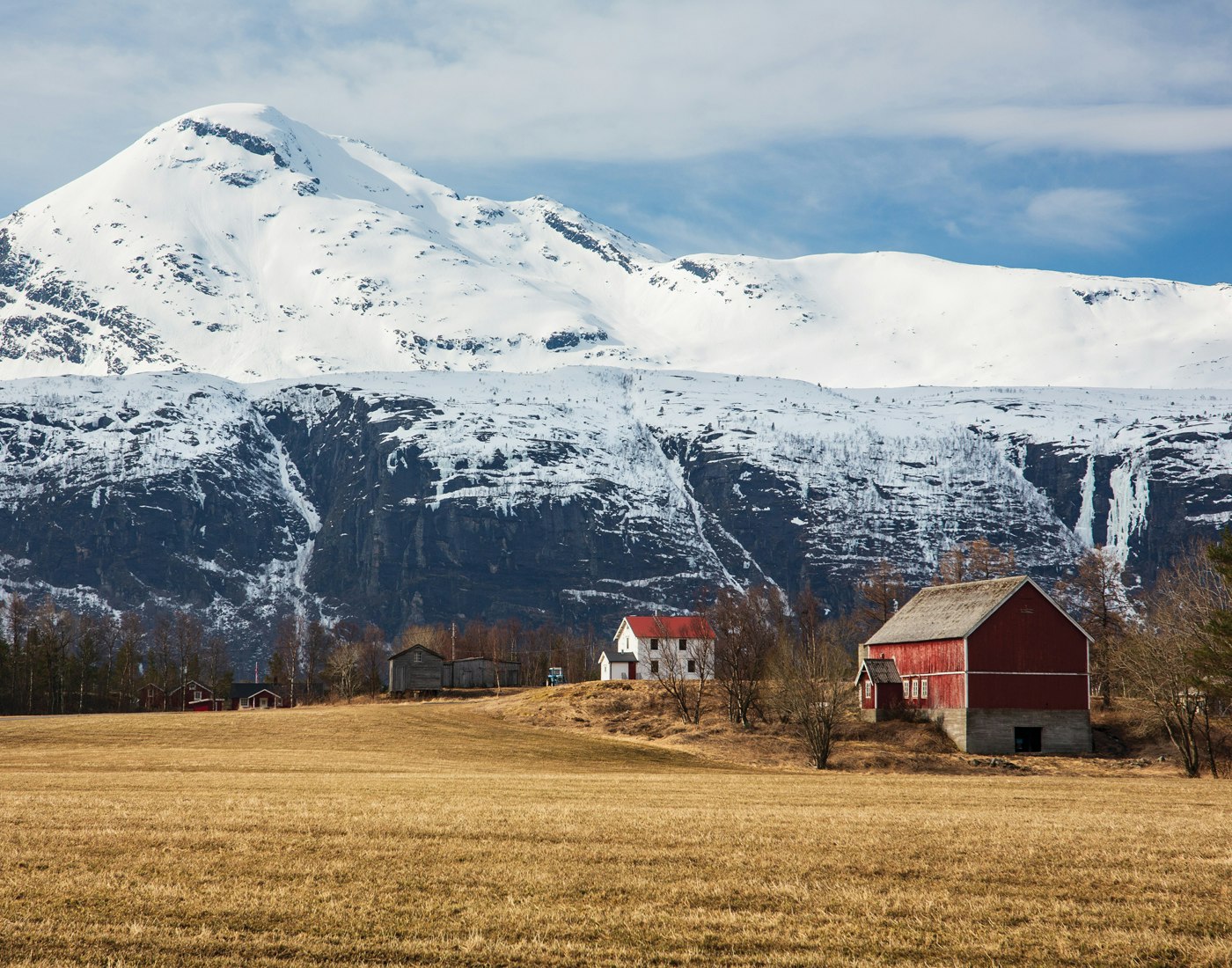
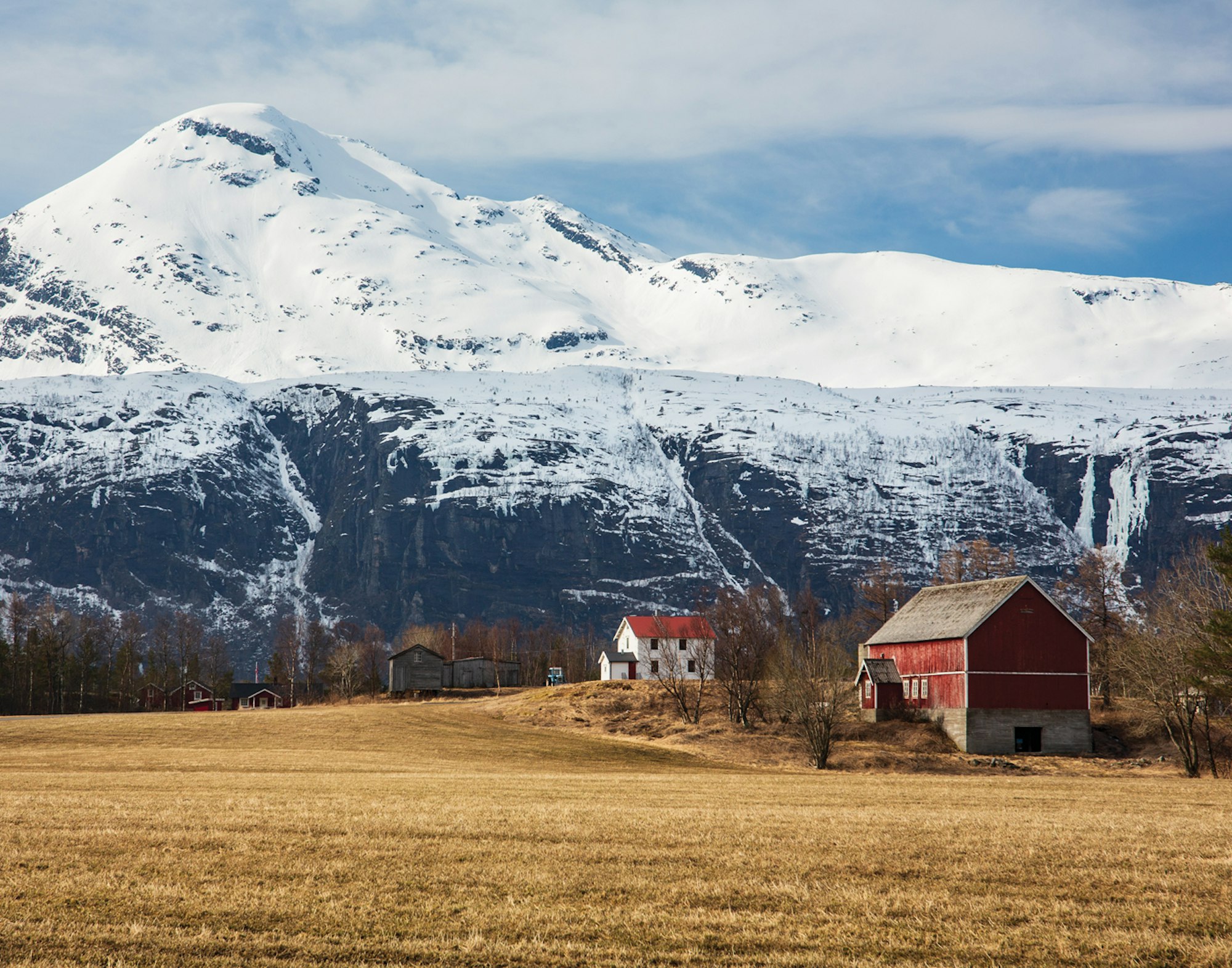
A contrast of seasons near the Skomen fjord.
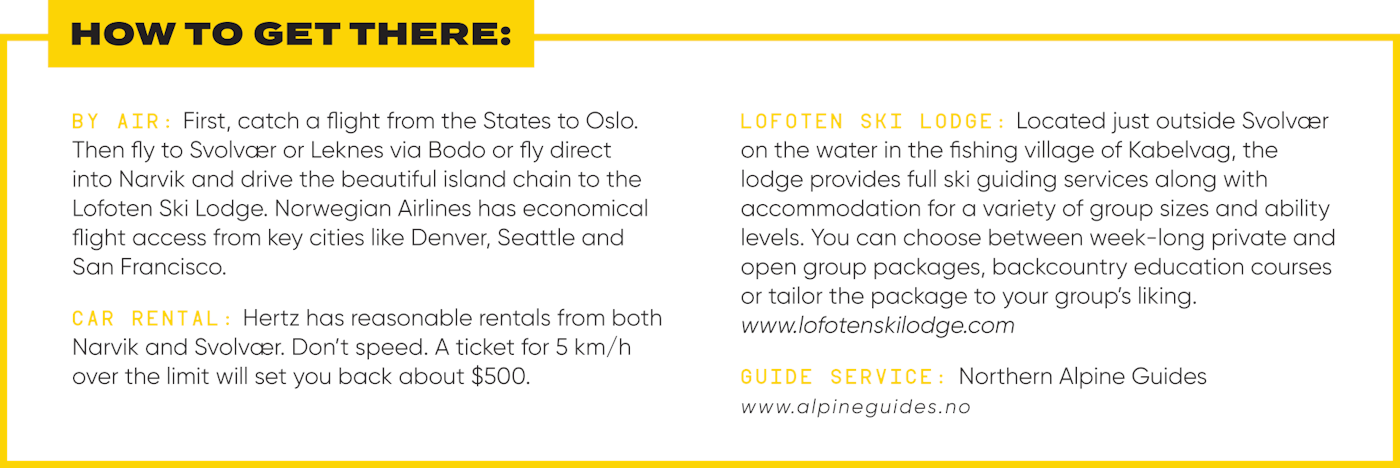
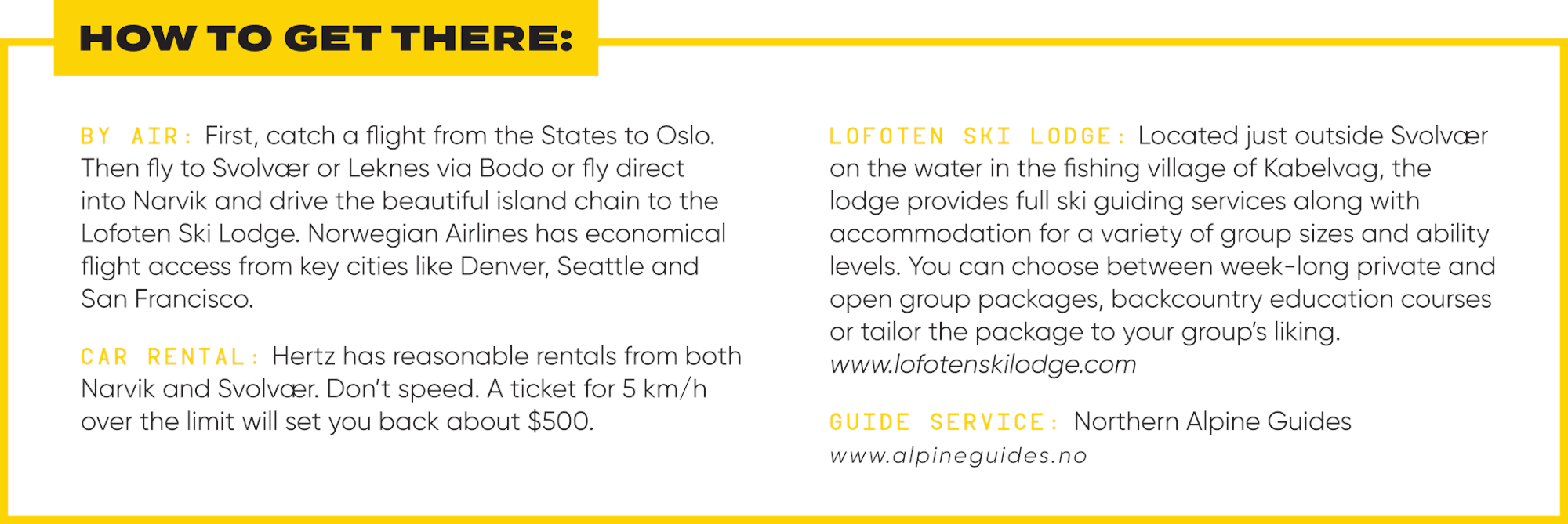
After a morning feast of smoked salmon, pickled herring, scrambled eggs and croissants, we packed the van and headed for Geitgallien, known affectionately by locals as “The Big G.” We parked along the ocean and began the three-hour climb up to the summit of Geitgallien, which turned out to be easily navigable via a perfect mix of walking, rock scrambling, bootpacking and skinning. As we gained the upper basin we could hear massive boulders tumbling from the rocky spires above, a sure sign that winter had given way to the warm caress of an Arctic spring. Once we gained the highest ridge, we peered over the ledge and into the void containing a perfect splitter line of velvety corn ripe for the taking. The final push to the summit platform provided a few spicy steps that got the blood flowing. From our elevated perch the island chain appeared endless and it became apparent that it would take a few seasons, if not decades, to really explore all the easily accessible skiing Lofoten had to offer from its network of roads. With a boat, one could be content spending a lifetime exploring the archipelago.
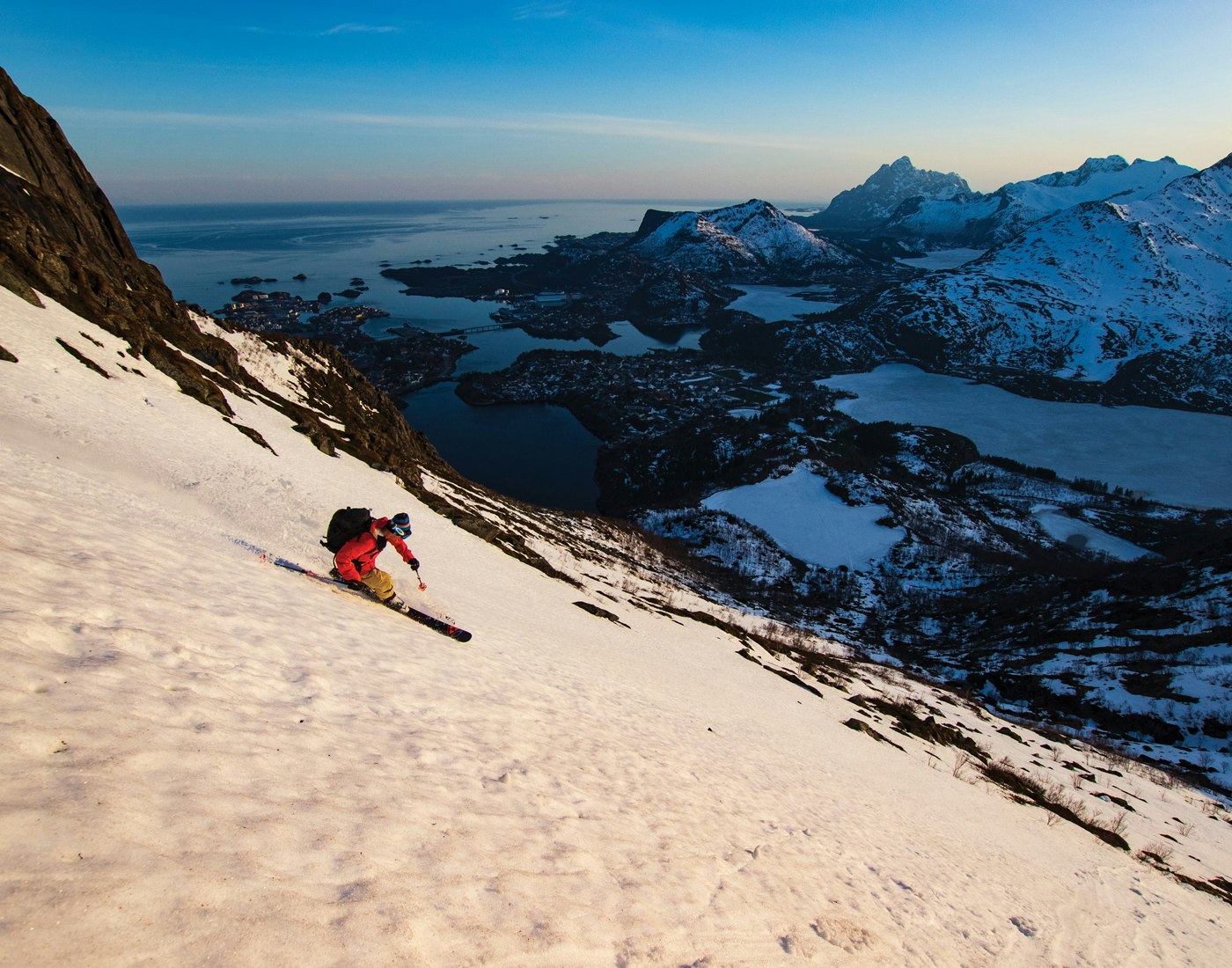
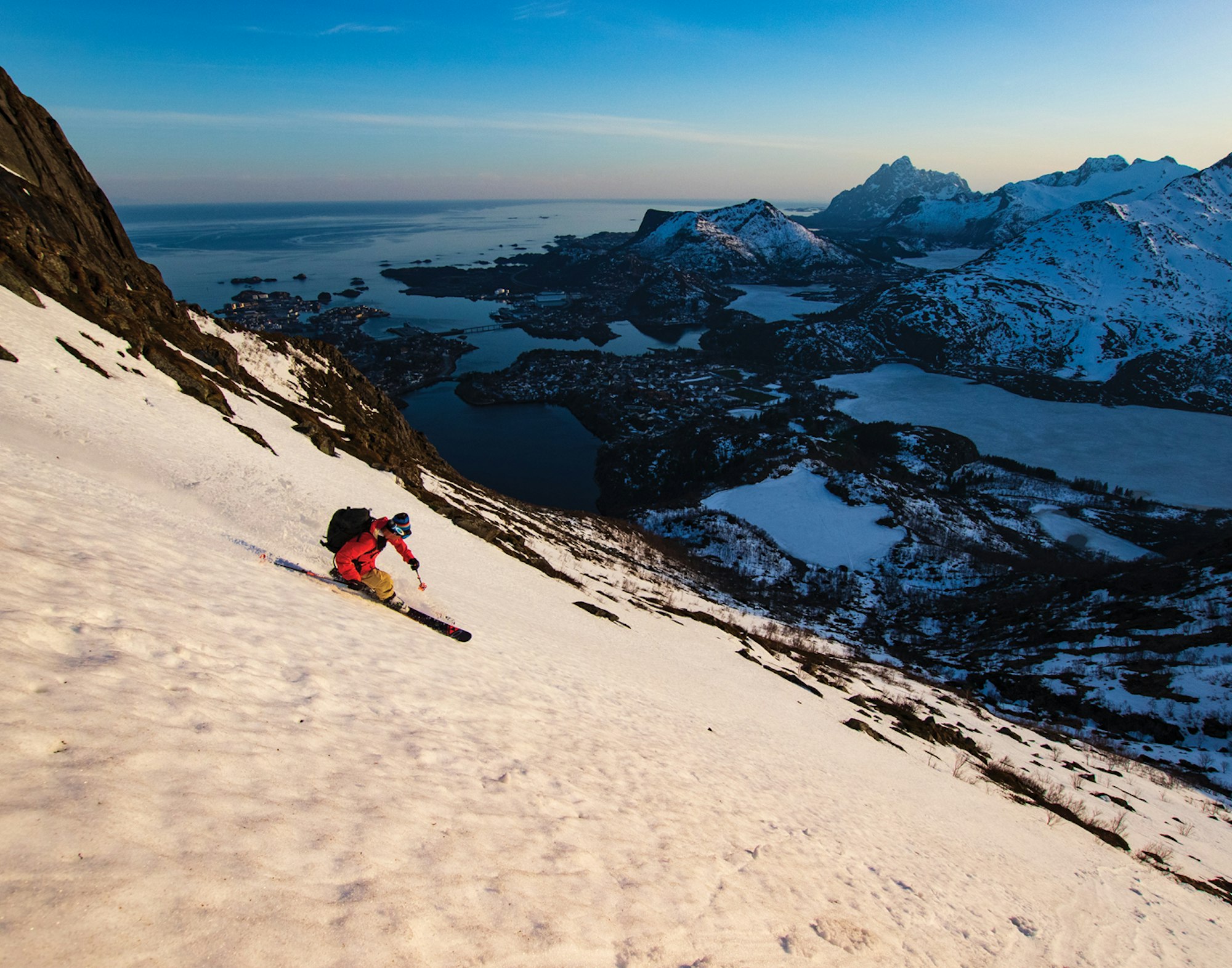
Enjoying after-dinner dessert skiing above Svolvær.
The South Couloir delivered the goods and exceeded our lofty expectations. The perfectly-pitched couloir held buttery snow for its duration and seemed to go on forever. As we exited the line, we met up and exchanged an obligatory high five, peering back up to see our tracks on the silky surface of the snow and then looking down at the vast apron still to be skied to the ocean below. The dream line ended a few hundred feet above the water and we stumbled through the boulder-strewn forest, intoxicated by our good fortune, to a primitive dirt road at the water’s edge. For the next thirty minutes, we walked in silence to the car where the grand adventure had commenced five hours prior, enjoying the sanctuary of Lofoten. The beer that night flowed freely and I enjoyed a Scandinavian tradition of soaking in the sauna until well-cooked and experiencing a rapid cooling courtesy of a plunge into the icy waters of the Norwegian Sea.
Many skiers spend nights lying awake replaying epic ski days of the past and pondering a bucket list for their future. I, too, had lain awake many a night doing the same. It took me 25 years and more than 40 international trips to tick this last destination off my list, but the journey provided memories and experiences that will inspire me for another quarter century. Through years of being denied, Lofoten became my Holy Grail, but the chase and capture exceeded my wildest dreams. Perhaps there’s something to be said for saving the best for last.
This story originally appeared in FREESKIER 22.4, The Destination Issue.

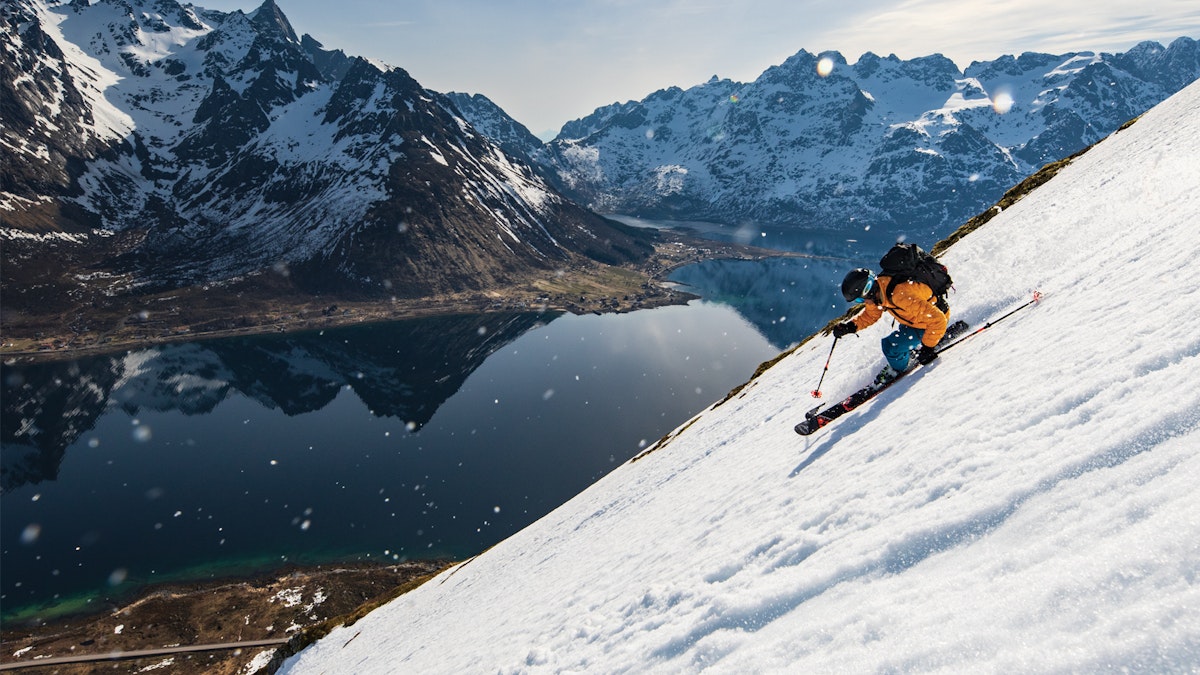
![[GIVEAWAY] Win a Legendary Ski Trip with Icelantic's Road to the Rocks](https://www.datocms-assets.com/163516/1765233064-r2r26_freeskier_leaderboard1.jpg?w=200&h=200&fit=crop)
![[GIVEAWAY] Win a Head-to-Toe Ski Setup from IFSA](https://www.datocms-assets.com/163516/1765920344-ifsa.jpg?w=200&h=200&fit=crop)
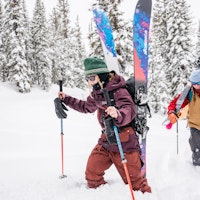
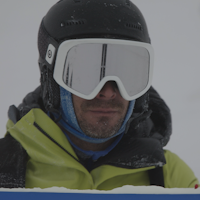
![[GIVEAWAY] Win a Legendary Ski Trip with Icelantic's Road to the Rocks](https://www.datocms-assets.com/163516/1765233064-r2r26_freeskier_leaderboard1.jpg?auto=format&w=400&h=300&fit=crop&crop=faces,entropy)


![[GIVEAWAY] Win a Head-to-Toe Ski Setup from IFSA](https://www.datocms-assets.com/163516/1765920344-ifsa.jpg?auto=format&w=400&h=300&fit=crop&crop=faces,entropy)


